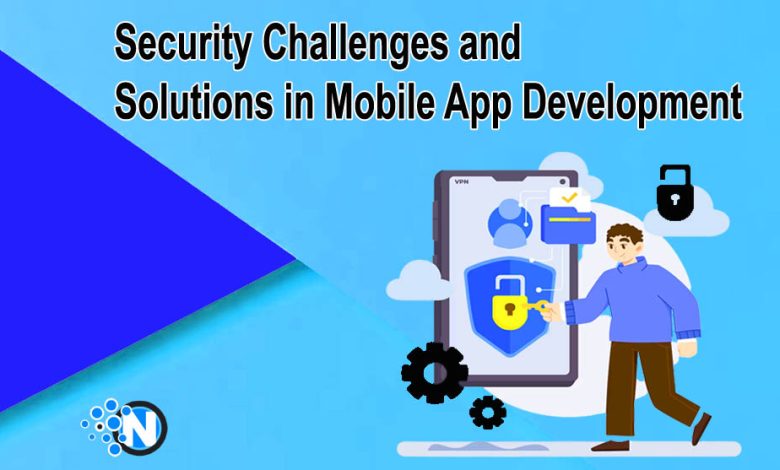Security Challenges and Solutions in Mobile App Development

Mobile apps have become an integral part of our daily lives in our digital culture. Communication, entertainment, commerce, and finance all rely on these applications. However, the rapid expansion of the mobile app industry has brought about numerous security vulnerabilities. The rapid increase of mobile phones for the transformation of sensitive data has also brought some potential security risks for developers to pay more profound attention to. In light of this, mobile app development faces several security challenges. This article aims to explore practical strategies to safeguard and uphold the security of these essential digital platforms.
Security Challenges in Mobile App Development
Some mobile security challenges that app developers must carefully tackle are detailed below.
1. Privacy and Data Cracks:
Mobile applications frequently manage confidential user data, encompassing personal information, financial particulars, and location data. Insufficient data encryption and flaws in security protocols can result in data breaches and privacy violations. Furthermore, in light of the increasing fear around the safeguarding of user data and the implementation of strict regulations such as the General Data Protection Regulation (GDPR) and the California Consumer Privacy Act (CCPA), neglecting to give priority to data security may lead to legal consequences.
2. Insecure Data Storage:
Developers often store sensitive data within the app or on the device itself. This data becomes susceptible to unauthorized access through malware or device theft if not properly encrypted. This risks user credentials, financial information, and other confidential data.
3. Inadequate Authentication and Authorization:
Weak authentication methods can lead to unauthorized access to the app and its functionalities. Additionally, insufficient authorization controls might enable unauthorized users to access sensitive parts of the app or perform actions they shouldn’t have access to, compromising the app’s security.
4. Unsecured Communication Channels:
In order to perform their many tasks, mobile applications rely extensively on network connectivity. There is a risk of data manipulation and interception during transmission if an application’s communication with a server lacks adequate security. As a result, attacks using a “Man in the Middle” (MitM) technique may become possible.
5. Code Flaws:
Inconsistencies in the app’s code can create openings for attacks. Common issues include poor input validation, buffer overflows, and injection attacks. Such vulnerabilities allow hackers to access the app and its underlying systems.
6. Third-Party Libraries and Integrations:
Third-party integrations and libraries can speed up development but pose a security risk. Attackers may use these libraries’ flaws or outdated code to compromise the app’s security if they are not updated often.
7. Jailbreaking and Rooting:
Jailbreaking (iOS) and rooting (Android) can remove the built-in security measures of mobile devices. This enables users to install unauthorized apps and exposes the device to various security risks. Apps running on jailbroken or rooted devices are more susceptible to attacks.
8. Social Engineering Attacks:
Social engineering attacks target human psychology, manipulating users into divulging sensitive information or performing actions that compromise security. Attackers might employ phishing, pretexting, or baiting tactics to trick users into revealing credentials or granting unauthorized access to their devices.
Educating users about these tactics and implementing robust authentication mechanisms can help mitigate the risk of social engineering attacks.
9. In-App Purchases and Financial Fraud:

Many mobile apps offer in-app purchases and handle financial transactions. Attackers can exploit vulnerabilities in payment gateways, transaction processes, or insecure APIs to conduct fraudulent transactions or steal credit card information.
Ensuring the app’s payment mechanisms are secure, integrating trusted payment gateways, and implementing two-factor authentication for financial transactions can help prevent such fraud.
10. Device Fragmentation and OS Vulnerabilities:
The diversity of mobile devices and operating systems (OS) introduces a challenge known as device fragmentation. Ensuring consistent security across various devices and OS versions can be difficult, as vulnerabilities might be specific to certain configurations.
Regularly updating the app to address new OS vulnerabilities and thoroughly testing the app on different devices can help mitigate the security risks associated with device fragmentation.
Security Solutions for Mobile App Development:
The solutions to these mobile app development challenges are given below in detail:
1. Secure Coding Practices:
Implement secure coding practices such as input validation, proper error handling, and code reviews. Regularly update the app’s codebase to patch vulnerabilities and stay up-to-date with the latest security standards.
2. Data Encryption:
At rest and during transmission, encrypt data by using robust encryption algorithms. This ensures that the data remains unreadable and unusable even if unauthorized access occurs.
3. Strong Authentication and Authorization:
Implement multi-factor authentication (MFA) to enhance user authentication. Utilize OAuth and OpenID Connect for secure authorization, allowing users to grant specific permissions to different app functionalities.
4. Secure Network Communication:
Use secure protocols like HTTPS and implement certificate pinning to ensure encrypted communication between the app and servers. This helps prevent MitM attacks and data interception.
5. Regular Security Testing:

Perform regular security assessments, including penetration tests and vulnerability scans. This helps identify and mitigate potential security flaws before attackers exploit them.
6. Third-Party Library Management:
Carefully vet third-party libraries and integrations before integrating them into your app. Regularly update these libraries to patch known vulnerabilities and minimize security risks.
7. App Hardening Techniques:
Employ app hardening techniques to deter reverse engineering and tampering. Techniques like obfuscation and anti-debugging measures make it more difficult for attackers to analyze and manipulate the app’s code.
8. Runtime Application Self-Protection (RASP):
Implementing a Runtime Application Self-Protection solution provides an extra layer of security by monitoring the app’s behavior during runtime. RASP tools can detect and prevent attacks such as code injection, SQL injection, and unauthorized access.
These solutions automatically identify and respond to suspicious activities, mitigating potential security risks without changing the app’s source code.
9. Secure Data Deletion:
Ensuring the secure deletion of data is crucial, especially when users uninstall the app or when sensitive data is no longer needed. Implement mechanisms that securely erase data from both the app’s cache and the device’s storage. By adhering to proper data disposal practices, developers can prevent residual data from falling into the wrong hands, mitigating the risk of data leakage.
10. User Education:

Customers should be provided with in-depth information regarding app security, which should include the potential risks associated with downloading applications from unreliable sources as well as the repercussions of tampering with their devices by either hacking or rooting them.
Conclusion:
The realm of mobile app development is unquestionably dynamic and indispensable, but it does present security challenges. As our reliance on mobile applications increases, so does the likelihood of security breaches. Nonetheless, realizing that these obstacles can be met and overcome with the proper strategies and vigilance is encouraging. Developers can effectively navigate this dynamic environment by implementing robust security measures, keeping abreast of emergent threats, and fostering a security-first mentality. In doing so, they not only secure their users’ data but also contribute to a safer and more reliable mobile app ecosystem for everyone.




